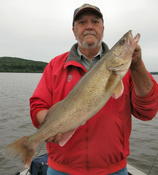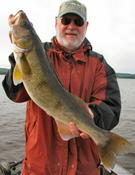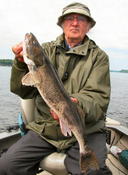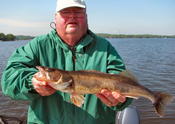 Water temperatures on Lake Wisconsin have finally warmed up into the low 70 degree range. Along with the warmer water, we are starting to see a few schools of bait fish on the sonar and walleyes & saugers are also starting to settle into patterns that are a bit more typical for this time of the year.
Water temperatures on Lake Wisconsin have finally warmed up into the low 70 degree range. Along with the warmer water, we are starting to see a few schools of bait fish on the sonar and walleyes & saugers are also starting to settle into patterns that are a bit more typical for this time of the year.
Mark Mowbray holds up his personal best walleye. The 27 incher fell for a crawler rig behind a bottom bouncer.
 Things change every year on most bodies of water. Sometimes those changes are noticeable and other years not so much.
Things change every year on most bodies of water. Sometimes those changes are noticeable and other years not so much.
There are some changes that have been noticeable this year on Lake Wisconsin.
One big change is in water clarity. Last years floods dumped tons of mud, sand, weeds, trees, brush and just about everything else in the lake. When the muddy water finally cleared up, the warm temperatures combined with extremely fertile water to cause massive algae blooms which lasted well into October of last year. The water clarity as you can imagine, was not so good.
This year, water clarity on Lake Wisconsin has been the best that I can ever remember. Cooler than normal temperatures through the months of April, May and early June have delayed and slowed algae blooms. Normal rain falls have dumped some mud into the system from time to time, but that’s pretty normal stuff and since Lake Wisconsin is a reservoir, it flushes itself out every few days.
Bill Urban caught his personal best walleye while trolling crank baits behind planer boards. His new PB walleye measured 27-1/2" long.
 Another major change from a normal year on Lake Wisconsin is the lack of gizzard shad. According to sources in the WDNR, the shad were unable to tolerate the extremely muddy conditions brought on by flooding in 2008. As a result, we have no where near normal numbers of this primary bait fish in the system at this time. Gizzard shad populations are expected to bounce back, but no one knows for sure just how fast they will be able to do that.
Another major change from a normal year on Lake Wisconsin is the lack of gizzard shad. According to sources in the WDNR, the shad were unable to tolerate the extremely muddy conditions brought on by flooding in 2008. As a result, we have no where near normal numbers of this primary bait fish in the system at this time. Gizzard shad populations are expected to bounce back, but no one knows for sure just how fast they will be able to do that.
(2008 fall walleye shocking surveys done by the WDNR found zero gizzard shad coming up between the boom shockers, which isn’t normal)
As a result, all predatory fish in this system had to change there feeding habits somewhat. Late last year already, we noticed that the larger walleyes & saugers were keying on smaller sheepshead.
It is also common for the walleyes & saugers to feed on small crappies & white bass. It’s not hard to believe they helped to fill the void left by the lack of primary baitfish.
With the lack of gizzard shad in the system, I’ve had my eyes open, looking for any sign of walleyes and/or saugers showing up looking like they were having a hard time finding enough food. So far, that has not been the case. We always have a few skinny fish at this time of the year, but overall, the walleyes & saugers look to be in very good shape. Thats very good news because we’ve finally reached the point and time where schools of bait fish have grown enough that game fish can target them if they choose too.
Dick Majcher holds up a beautiful 22-3/4" long sauger.
 The 3rd major change we’ve seen on Lake Wisconsin this year is directly related to the slot limits enacted back in March, 2002. It is now common to catch walleyes in the 20-28" range and fish over 28" long are becoming more common all the time. Catching saugers up to 23" long is also becoming a common occurrence.
The 3rd major change we’ve seen on Lake Wisconsin this year is directly related to the slot limits enacted back in March, 2002. It is now common to catch walleyes in the 20-28" range and fish over 28" long are becoming more common all the time. Catching saugers up to 23" long is also becoming a common occurrence.
Overall numbers of keeper size walleyes & saugers, those between 15-20" long, appear to be declining a little bit. And except for the meat hunters, most of us are more than happy to sacrifice a keeper fish or two for a legitimate crack at a new personal best walleye or sauger.
Walleyes & saugers under 15" appear to be holding their own just fine. At least when viewing my personal records which I’ve been keeping for the past four years. That recruitment is important because the future fishery depends on small fry to fill the void left by the fish that are taken out of the system each year.
Changes are always occurring on a yearly basis in most fisheries. Those I just listed are the most noticeable changes that we’ve see over the past year here on Lake Wisconsin.
Tom Bartells with a 21" sauger.
1st pic – Mark Mowbray, 21″ sauger.
2nd pic – Bill Urban, 26″ flathead.
3rd pic – Rob Linde, 20″ plus sauger.
4th pic – Rich Schoenberger
Great fish guys
Great Job Joel! Awesome read and beautiful big fish pictures as usual!
Previous to the slot being enforced, were you still able to readily encounter fish of this caliber?
Pete
We always have been able to catch a few big, heavy fish in years past but no where near the numbers like this year.
Yet another terrific report Joel! I love the way you incorporate the “big picture” view of Lake Wisconsin into your reports. Reading how the slot affected your fishing is very similar to what I see on Pool 14, with many more 24-27″ fish than I’ve ever seen.



Covering the water clarity, history, temps and slot gives us a great picture of the fabulous fishery you have there. Thanks for sharing!
Great report Joel and congrats on putting your clients on some good fish!
Compared to last year, how have you changed your approach (tactics) in regard to having clearer water clarity?
It doesn’t look like the changes on Lake Wisconsin have slowed you down a bit Joel, you are still playing an A game

The slot limit looks to be doing it’s job also…….23inch Saugers, numbers of eyes over 20 inches
Another great read and picuters Joel

On clear, sunny days I have started adding a flourocarbon leader to the end of my lines. Six feet of 14lb XPS flourocarbon line on my trolling lines and three feet of 8lb XPS flourocarbon gets tied to my jigging rods when we decide to drag jigs tipped with crawlers.
(On a side note, flat calm, sunny days have made for some real tough crank bait trolling days. We usually go with crawler rigs behind bottom bouncers on those days)
On the cloudy or rainy days, I have not felt the need for the flourocarbon line. If its already tied up that way, I leave it on. If I break a line on a rainy or cloudy day, I don’t bother adding the flourocarbon.
Our water is still not super clear by any means and with the warm weather, we are starting to see some algae blooms. Nothing bad yet but it does add quite a bit of color to the water and the algae also helps prevent the penetration of sunlight.
Very nice fish and report Joel!!!
WOW Great report Joel. That Sauger pic in your report is a TANK for this time of year. There is just something about helping someone get their PB eye that makes me smile. You sure do that a lot.

Great recap on how you see the lake changing. This is important thing to keep track of IMO, as it helps you understand the fish and their patterns better.
Your report gave me the itch even more, as I’m making my maiden voyage this year for pulling boards on Saturday! C’mmmmmmmmmmmmmoon FISH!